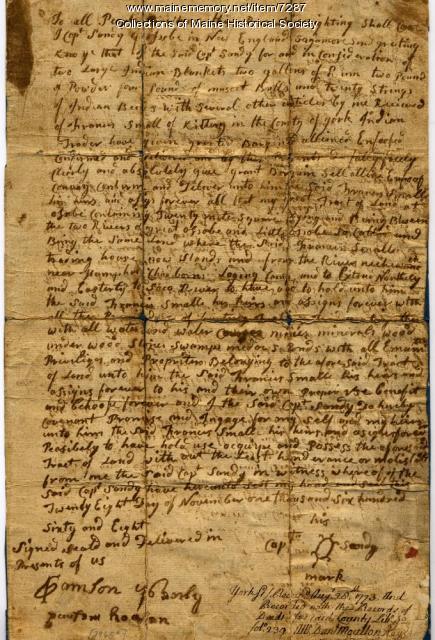Ancestor: Francis Small
Descendant: Scott H.
In 1668 Francis Small, my 7th great-grandfather was living in Kittery, Maine and running a trading post in what is now Cornish, Maine where the Ossipee and Saco Rivers meet.
This location was very favorable for trading with the Indians since several of their trails passed through there. These trails were known as the Sokokis Trail (now Route 5), the Ossipee Trail (now Route 25) and the Pequawket Trail (now Route 113). But this location was also in the wilderness entailing the risks that went with it.
While at this trading post Francis was warned by Wesumbe, a local sachem with whom he had developed a friendship, of a planned attempt on his life by renegade tribesmen. They were indebted to the trader, having purchased goods in the spring on credit, to be paid in the fall with furs.
Instead, they decided to erase the debt by killing him at early dawn on a certain day, setting fire to his house and shooting him when he ran out the door. At first Small thought the warning a trick to frighten him away and avoid payment. Just to be on the safe side, however, he took refuge on a nearby hill, from which he could peer through the pines and observe what would transpire. Sure enough, at first light his trading post went up in flames, illuminating the dark forest. Small began running and didn’t stop until he reached Kittery.
As compensation for his losses, Chief Wesumbe sold to Small on November 28, 1668, twenty square miles of land, in all 256,000 acres, between the Ossipee River, Little Ossipee River, and Newichewannock River (now Salmon Falls River). The price was two large Indian blankets, two gallons of rum, two pounds of powder, four pounds of musket balls and twenty strings of Indian beads.
The purchase comprised what is called the Ossipee Tract – Limington, Limerick, Cornish (formerly named Francisborough after its early proprietor), Newfield, Parsonfield, and Shapleigh (part of which was set off as Acton). Small thereupon sold a half interest in the Ossipee Tract to Major Nicholas Shapleigh, who lived at what is now Eliot, and was then the richest man in the Piscataqua River region.

